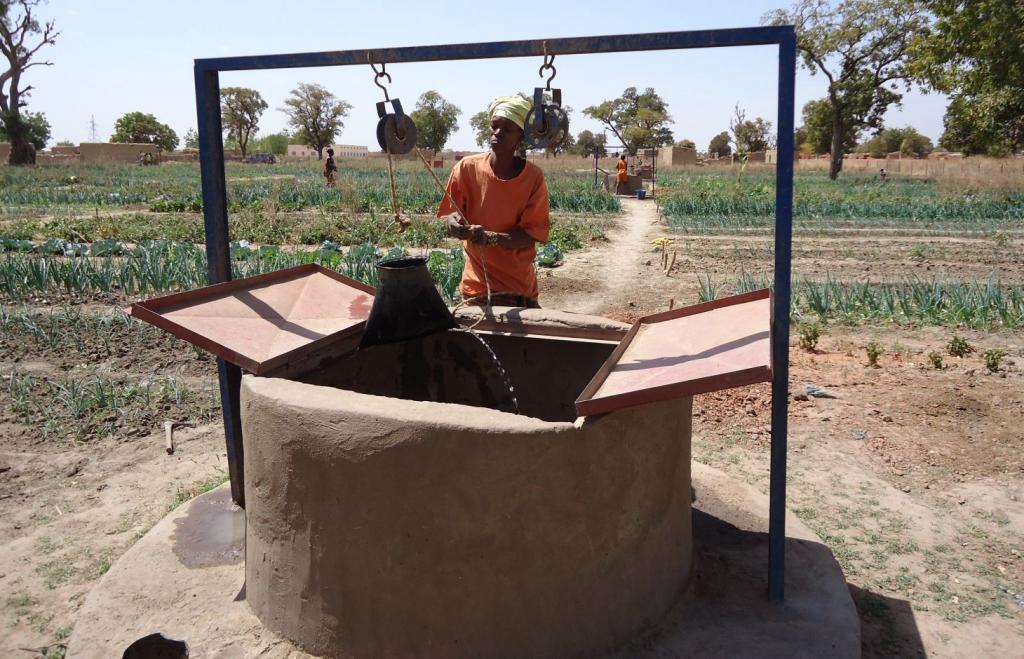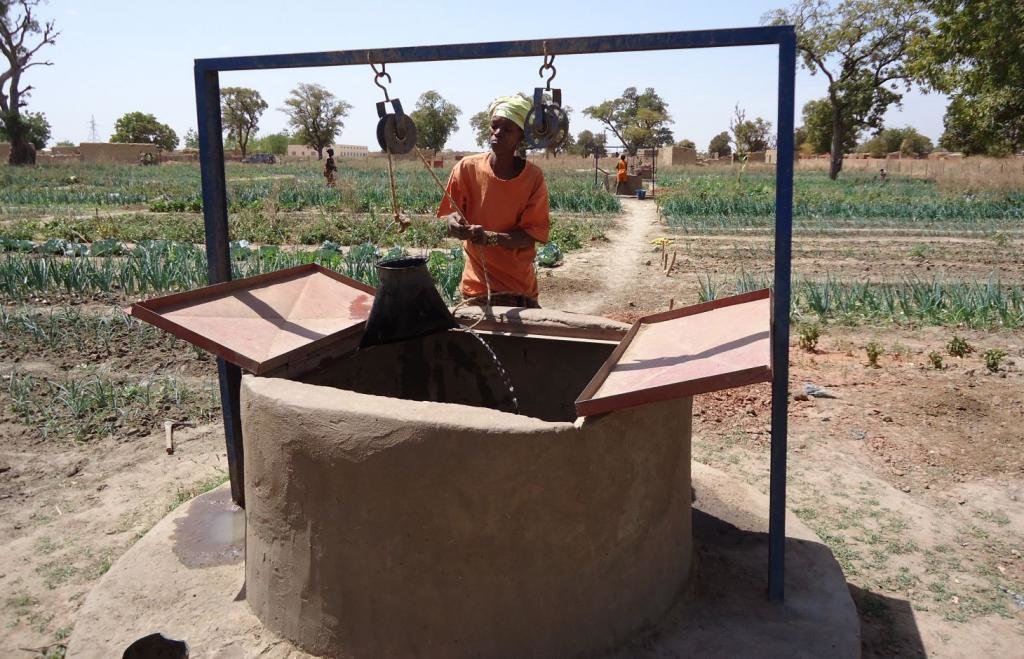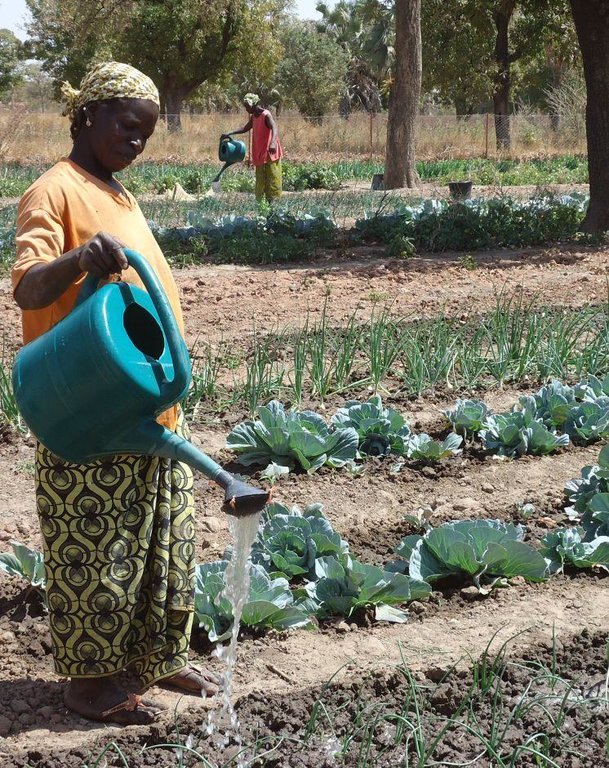Diversifying women’s income streams through market gardening [马里]
- 创建:
- 更新:
- 编制者: Dieter Nill
- 编辑者: –
- 审查者: Laura Ebneter
Diversification des revenus des femmes par des jardins maraichers
approaches_2501 - 马里
查看章节
全部展开 全部收起1. 一般信息
1.2 参与方法评估和文件编制的资源人员和机构的联系方式
SLM专业人员:
Diassana Joseph
jd@bornefondenmali.org
BØRNEfonden - Children & Youth Foundation
马里
SLM专业人员:
Coulibaly Sourakata
sc@bornefondenmali.org
BØRNEfonden
马里
有助于对方法进行记录/评估的机构名称(如相关)
Deutsche Gesellschaft für Internationale Zusammenarbeit (GIZ) - 德国有助于对方法进行记录/评估的机构名称(如相关)
BØRNEfonden - Children & Youth Foundation - 丹麦1.3 关于使用通过WOCAT记录的数据的条件
(现场)数据是什么时候汇编的?:
01/07/2012
编制者和关键资源人员接受有关使用通过WOCAT记录数据的条件。:
是
2. SLM方法的描述
2.1 该方法的简要说明
Establishing vegetable plots for women enables them to increase their incomes and improve their health by increasing and diversifying agricultural production and improving the nutritional quality of their food.
2.2 该方法的详细说明
该方法的详细说明:
Market gardening also enables women to set up savings funds through their associations, builds their capacity to organise and manage market gardens and improves their cultivation techniques. Market gardens set up by women’s associations are usually sited adjacent to lowland areas or rivers so as to facilitate access to water, which is extracted from wells. The areas of these market gardens range from 0.5 to 1 hectare depending on the size of the association and the opportunities for selling produce locally. Allotment sizes range from 80 to 120 square metres per woman. The number of growers per market garden is no greater than 70 women per hectare and 35 women per half-hectare. Women receive a grant in the form of equipment and agricultural inputs. The wells created for the market gardens are 1.4 metres in diameter, have 60-centimetre-high well heads and 30-centimetre-wide footpaths from which to water crops. Eight wells are installed per hectare across the site.
1)A women’s association puts forward its needs, 2)The BØRNEfonden Development Unit carries out a scoping study, 3) Women are organised into an association, 4) The women contribute their share of the costs (10% of the investment costs), 5) A site with guaranteed access to water (i.e. close to the water table) is enclosed, 6)The market garden’s wells are dug, 7)Financial support is provided during the first growing season to pay for equipment and agricultural inputs, 8)The association undertakes a self-assessment and draws up a training plan, 9)BØRNEfonden’s Development Units provide time-limited advisory support, the duration of which depends on capacity-building needs and ranges from three to five years per village. A four-month period of advisory support is allotted to service providers (technical services and consultancies). In order to achieve the best outcomes, it is important to define rules and requirements upfront. These requirements are met by developing an internal control system and nominating an internal control committee. The beneficiaries draw up the management procedures for their site, setting out how it is accessed and how women farmers are selected through internal regulation. Selected committee members receive training in organising and managing the site. Management tools are put in place for this purpose. A plan for the growing season is drawn up with women growers, which means needs can also be evaluated. BØRNEfonden provides the funding. The production costs of sold crops are evaluated and the required funds are then reimbursed by growers through the payment of subscription fees, using a payment system that they have collectively defined. Subscriptions paid by the women are safely set aside in the savings fund created by the association in order to ensure repayments can be made on the equipment paid for by BØRNEfonden.
The women’s association makes a suitable site available and prepares the soil (clearing, grubbing and ploughing). It also contributes a 10% share of the investment and opens a bank account to provide for the repayment of the investment. BØRNEfonden undertakes site development works (laying out, well digging, fencing), carries out crop planning, buys in equipment and agricultural inputs, installs nurseries, establishes and allocates plots, prepares seedbeds, transplants seedlings, and deploys plant health products and fertilisers. BØRNEfonden supports scheme farmers with the growing, harvesting and sale of produce. Local authorities sign the service contracts established between BØRNEfonden and the private contractors hired when the market garden activities got underway (well digging and site fencing). Government and consultancy technical services are involved in performing studies, delivering training in cultivation techniques and monitoring vegetable growing plots.
2.3 该方法的照片
2.5 采用该方法的国家/地区/地点
国家:
马里
区域/州/省:
Mali
有关地点的进一步说明:
Yanfolila, Bougouni and Dioïla in the regions of Koulikoro and Sikasso
2.6 该方法的开始和终止日期
注明开始年份:
2008
2.8 该方法的主要目的/目标
The Approach focused mainly on SLM with other activities
To increase women's incomes and improve their health by increasing and diversifying agricultural production and improving the nutritional quality of their food. Market gardening also enables women to set up savings funds through their associations, builds their capacity to organise and manage market gardens and improves their cultivation techniques.
The SLM Approach addressed the following problems: lack of work, money and food for women; negative ecological impact due to traditional practices such as deforestation or gold mining;
2.9 推动或妨碍实施本办法所适用的技术的条件
财务资源和服务的可用性/可得性
- 阻碍
lack of money
Treatment through the SLM Approach: BØRNEfonden provides the funding. The production costs of sold crops are evaluated and the required funds are then reimbursed by growers through the payment of subscription fees, using a payment system that they have collectively defined. Subscriptions paid by the women are safely set aside in the savings fund created by the association in order to ensure repayments can be made on the equipment paid for by BØRNEfonden.
机构设置
- 阻碍
Treatment through the SLM Approach: BØRNEfonden supports scheme farmers with the growing, harvesting and sale of produce.
了解SLM,获得技术支持
- 阻碍
Treatment through the SLM Approach: BØRNEfonden undertakes site development works (laying out, well digging, fencing), carries out crop planning, buys in equipment and agricultural inputs, installs nurseries, establishes and allocates plots, prepares seedbeds, transplants seedlings, and deploys plant health products and fertilisers.
3. 相关利益相关者的参与和角色
3.1 该方法涉及的利益相关者及其职责
- 当地土地使用者/当地社区
- SLM专家/农业顾问
- NGO
BØRNEfonden
- 国家政府(规划者、决策者)
Government and consultancy technical services are involved in performing studies, delivering training in cultivation techniques and monitoring vegetable growing plots.
3.2 当地土地使用者/当地社区参与该方法的不同阶段
| 当地土地使用者/当地社区的参与 | 指定参与人员并描述活动 | |
|---|---|---|
| 启动/动机 | 被动 | |
| 计划 | 互动 | |
| 实施 | 互动 | |
| 监测/评估 | 被动 | |
| Research | 被动 |
3.4 有关SLM技术选择的决策
具体说明谁有权决定选择要实施的技术:
- 主要是土地使用者,由SLM专家提供支持
解释:
Decisions on the method of implementing the SLM Technology were made by mainly by land users supported by SLM specialists
4. 技术支持、能力建设和知识管理
4.1 能力建设/培训
是否为土地使用者/其他利益相关者提供培训?:
是
明确受训人员:
- 土地使用者
培训形式:
- 在职
- 农民对农民
- 公开会议
- 课程
4.2 咨询服务
土地使用者有权使用咨询服务吗?:
是
指明是否提供了咨询服务:
- 在土地使用者的土地上
说明/注释:
Advisory service is quite adequate to ensure the continuation of land conservation activities
4.3 机构强化(组织发展)
是否通过这种方法建立或加强了机构?:
- 是,非常
具体说明机构的强化或建立程度:
- 本地
具体说明支持类型:
- 财务
- 能力建设/培训
- 设备
4.4 监测和评估
监测和评估是该方法的一部分吗?:
是
注释:
Bio-physical aspects were ad hoc monitored by project staff through observations
Technical aspects were ad hoc monitored by project staff through observations
Socio-cultural aspects were ad hoc monitored by project staff through observations
Economic / production aspects were regular monitored by project staff through measurements
Area treated aspects were regular monitored by project staff through measurements
Land users involved aspects were regular monitored by project staff through measurements
Management of Approach aspects were ad hoc monitored by project staff through observations
There were no changes in the Approach as a result of monitoring and evaluation
There were no changes in the Technology as a result of monitoring and evaluation
4.5 研究
研究是该方法的一部分吗?
是
明确话题:
- 社会学
- 经济/市场营销
- 生态学
- 技术
5. 融资和外部物质支持
5.1 该方法中SLM组成部分的年度预算
如果不知道准确的年度预算,请给出一个范围:
- 2,000-10,000
注释(例如主要的资助来源/主要捐助者):
Approach costs were met by the following donors: international non-government (BØRNEfonden): 90.0%; local community / land user(s): 10.0%
5.2 为土地使用者提供财政/物质支援
土地使用者是否获得实施该技术的财政/物质支持?:
是
5.3 对特定投入的补贴(包括劳动力)
- 设备
| 具体说明哪些投入得到了补贴 | 程度如何 | 对补贴做出具体说明 |
|---|---|---|
| 机械 | 充分融资 | |
| 工具 | 充分融资 | |
- 农业
| 具体说明哪些投入得到了补贴 | 程度如何 | 对补贴做出具体说明 |
|---|---|---|
| 种子 | 充分融资 | |
| 化肥 | 充分融资 | |
如果土地使用者的劳动力是一项重要的投入,那么是不是:
- 自愿
6. 影响分析和结论性陈述
6.1 方法的影响
该方法是否帮助土地使用者实施和维护SLM技术?:
- 否
- 是,很少
- 是,中等
- 是,支持力度很大
This new occupation deters women from taking up traditional practices that involve deforestation or environmental damage (gold mining). In light of these very encouraging levels of income, women producers will be more interested in sustaining and continuing their market gardening activities.
该方法是否有助于社会和经济弱势群体?:
- 否
- 是,很少
- 是,中等
- 是,支持力度很大
focus on women
Did other land users / projects adopt the Approach?
- 否
- 是,很少
- 是,中等
- 是,支持力度很大
The activity has been operating since 2008 with increasing success. Since 2008, 21 development units have supported the installation and management of 57 market gardens, 14 nutrition gardens (based on strip-farmed food crops and jujubes), and 286 wells across a total area of 32.3 hectares. The total number of women farmers involved stands at 2,752. Schemes were installed in 27 communes across the three circles of Yanfolila, Bougouni and Dioïla in the regions of Koulikoro and Sikasso. 26 villages benefited from the installation of market gardens in 12 rural communes in the Koulikoro Region. 31 villages benefited from the installation of market gardens in 15 communes in the Sikasso Region.
Did the Approach lead to improved livelihoods / human well-being?
- 否
- 是,很少
- 是,中等
- 是,支持力度很大
Dietary diversification resulting from the communities’ (and particularly children’s) access to vegetables and the introduction of certain crops like potato and French beans. The consumption of vegetables and having the financial means to buy different kinds of foods improve the nutritional quality of diets.
Did the Approach help to alleviate poverty?
- 否
- 是,很少
- 是,中等
- 是,支持力度很大
Some of these women have already been able to capitalise on their incomes by buying livestock (cows, small ruminants). Ensuring women are well organised across the market garden site, promoting good management and increasing the purchasing power of producers are equally important factors in achieving sustainability.
6.2 土地使用者实施SLM的主要动机
- 增加生产
- 增加利润(能力),提高成本效益比
- 支付/补贴
6.3 方法活动的可持续性
土地使用者能否维持通过该方法实施的措施(无外部支持的情况下)?:
- 是
若是,请说明如何维持:
The women are now able to reproduce the same approaches. With BØRNEfonden’s support, they have the funds to buy good quality agricultural inputs, which guarantees good production. The savings held in their bank accounts help with equipment repayments.
6.4 该方法的长处/优点
| 编制者或其他关键资源人员认为的长处/优势/机会 |
|---|
| Environmental impacts: a sharp drop in the overcutting of trees to make charcoal, and a sharp drop in traditional gold mining activities and their negative environmental impacts |
| The consumption of vegetables and having the financial means to buy different kinds of foods improve the nutritional quality of diets. |
| Dietary diversification resulting from the communities’ (and particularly children’s) access to vegetables and the introduction of certain crops like potato and French beans. |
| Women’s takings from their vegetable crops range from 35,000 to 125,000 CFA francs, depending on the production scenario and location. We have recorded sales of between 7.5 and 8 tonnes of potato resulting from 25 crates of seed potato. Sold at a rate of 225 CFA francs per kilogram, this generates a total of between 1,687,500 to 1,800,000 CFA francs. |
|
Strengthening the capacities of women vegetable growers ensures the sustainability of this good practice. Indeed, the women are now able to reproduce the same approaches. With BØRNEfonden’s support, they have the funds to buy good quality agricultural inputs, which guarantees good production. The savings held in their bank accounts help with equipment repayments. |
| Market gardening is now being carried out at times when women would traditionally have been without work and lacking money and food. This new occupation deters women from taking up traditional practices that involve deforestation or environmental damage (gold mining). In light of these very encouraging levels of income, women producers will be more interested in sustaining and continuing their market gardening activities. Some of these women have already been able to capitalise on their incomes by buying livestock (cows, small ruminants). Ensuring women are well organised across the market garden site, promoting good management and increasing the purchasing power of producers are equally important factors in achieving sustainability. |
6.5 该方法的弱点/缺点以及克服它们的方法
| 编制者或其他关键资源人员认为的弱点/缺点/风险 | 如何克服它们? |
|---|---|
| The constraints to report relate to: low-rainfall periods (drying up of wells), pests attacking crops, and problems selling crops (poor sales, low sale prices). |
7. 参考和链接
7.1 方法/信息来源
- 实地考察、实地调查
- 与土地使用者的访谈
7.2 参考可用出版物
标题、作者、年份、ISBN:
Manual of Good Practices in Small Scale Irrigation in the Sahel. Experiences from Mali. Published by GIZ in 2014.
可以从哪里获得?成本如何?
http://star-www.giz.de/starweb/giz/pub/servlet.starweb
标题、作者、年份、ISBN:
Procedures and technical specifications for market garden schemes, BØRNEfonden – Mali
链接和模块
全部展开 全部收起链接
无链接
模块
无模块




